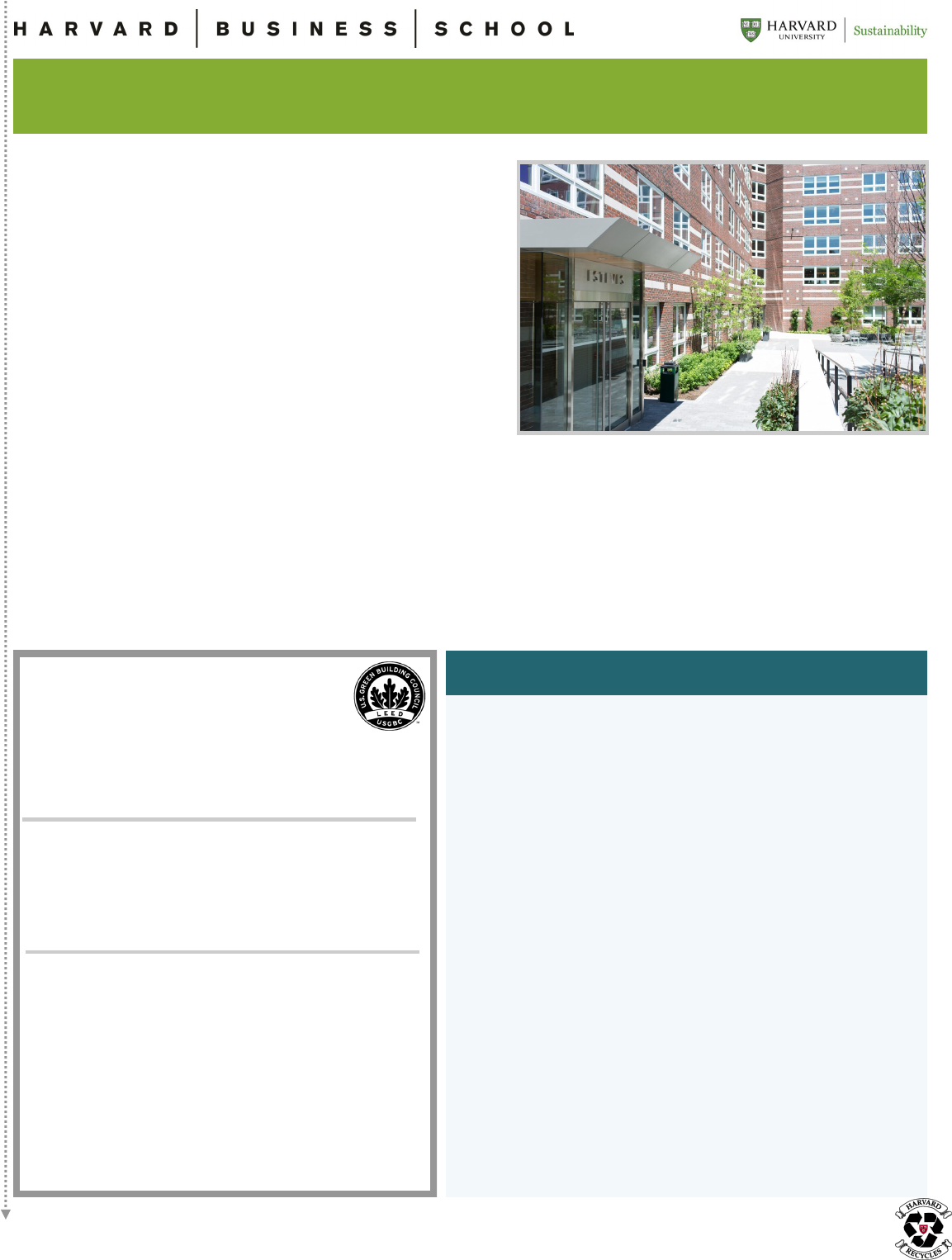
Please print this project profile only if necessary.
If printing is required, please print double sided and recycle when finished. Thank you!
-
LEED
®
Facts
Harvard Business School
Esteves Hall Executive Education
Residence
Location……………………………………..Boston, MA
Rating System…………………….…….….LEED-CI v3
Certification Awarded………………….……….. Platinum
Total Points Awarded….………………………..85/110
Sustainable Sites…………………………………. 21/21
Water Efficiency…….……………………….….... 11/11
Energy and Atmosphere………...…………….... 28/37
Materials and Resources………..……….……..... 4/14
Indoor Environmental Quality………………….. 12/17
Innovation and Design…………………………...… 5/6
Regional Priority……………………………………...4/4
percent water savings compared to an
Energy Policy Act of 1992 baseline
percent of installed equipment and appli-
ances are Energy Star cered
reducon in installed lighng power density
(LPD) compared to ASHRAE 90.1-2007
percent in annual potable water used for
landscape irrigaon
of individual spaces, including bedrooms,
have individual lighng controls
of individual spaces, including bedrooms,
have individual thermal comfort controls
The Esteves Hall Execuve Educaon Residence facility serves as a
model for high performance building design on the Harvard Business
School (HBS) campus. The project’s renovaon is centered on creang
a healthy and sustainable learning, living and working environment
that is focused on human comfort, energy and water conservaon, and
environmental stewardship.
The 6-story, 75,429 square foot mul-use building, located to the west
of the Charles River, provides living and learning spaces for the HBS
Execuve Educaon Program. Esteves Hall houses 20 living groups with
165 bedrooms and associated living group lounges, recepon lounges,
and administrave oces.
The project team applied an integrated approach to sustainable
design, which incorporated environmental strategies that inuenced all aspects of the building’s design. The site and landscape
were designed to reduce stormwater runo and create a comfortable outdoor environment. Building envelope upgrades were
designed to meet a high performance target for occupant comfort while reducing total energy use of the building. The energy
ecient lighng system creates well-lit places for students and sta while also reducing energy consumpon via daylight and
occupancy sensors . The high eciency HVAC system provides comfort, high indoor air quality, user controls, and energy
conservaon, while the plumbing design strategy conserves potable water use. The project design achieved LEED Planum
cercaon.
Photo Copyright Susan Young, Harvard Business School, 2015
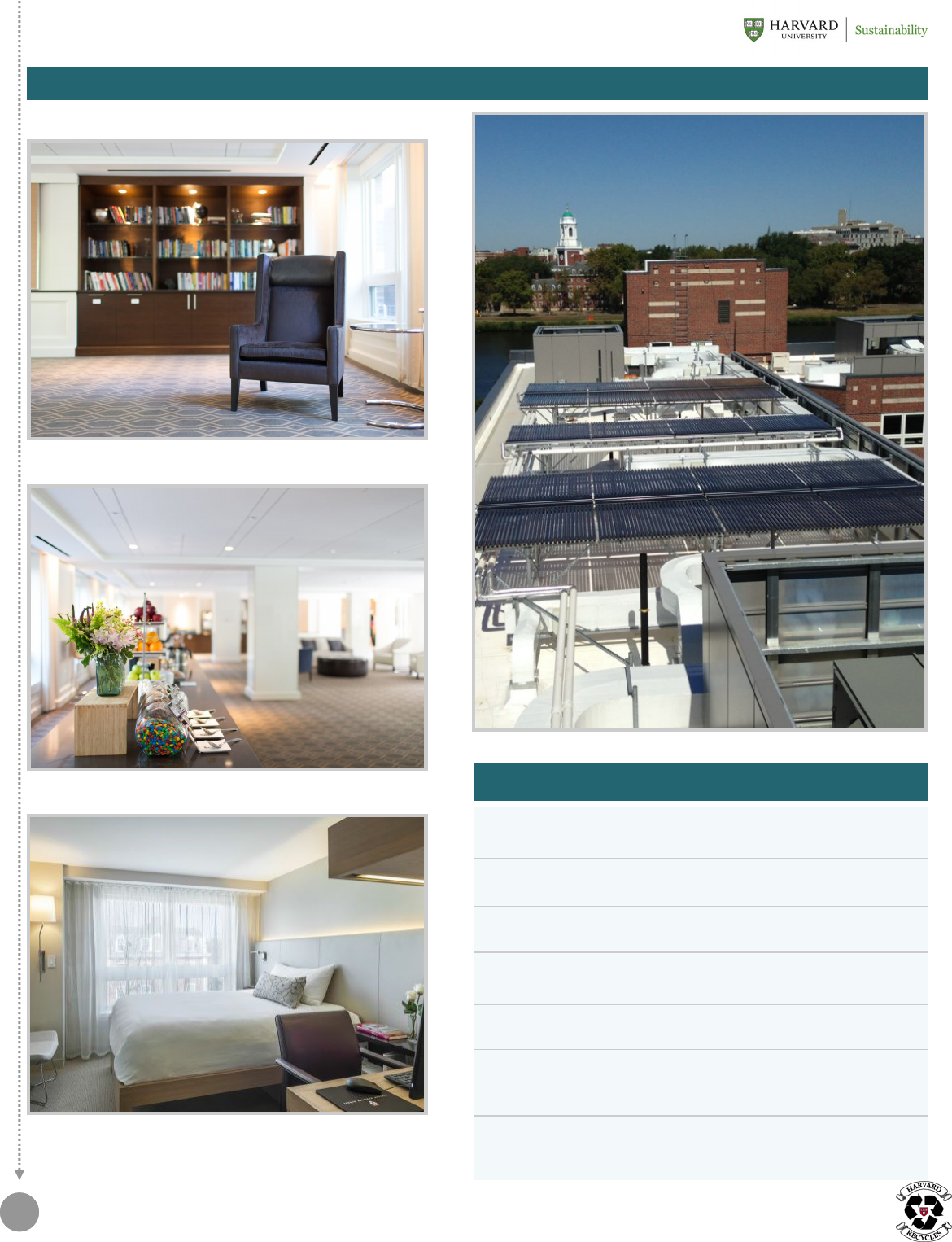
2
Please print this project profile only if necessary.
If printing is required, please print double sided and recycle when finished. Thank you!
Harvard Business School
CSL Consultants
CBT Architects
Vanderweil Engineers
Lee Kennedy Company
BR+A Engineers
Harvard Green Building Services
Rooftop Solar Thermal System—Photo Copyright Kingspan Environmental 2015
Photo Copyright Richard Mandelkorn, 2015
Photo Copyright Susan Young, Harvard Business School, 2015
Photo Copyright Susan Young, Harvard Business School, 2015
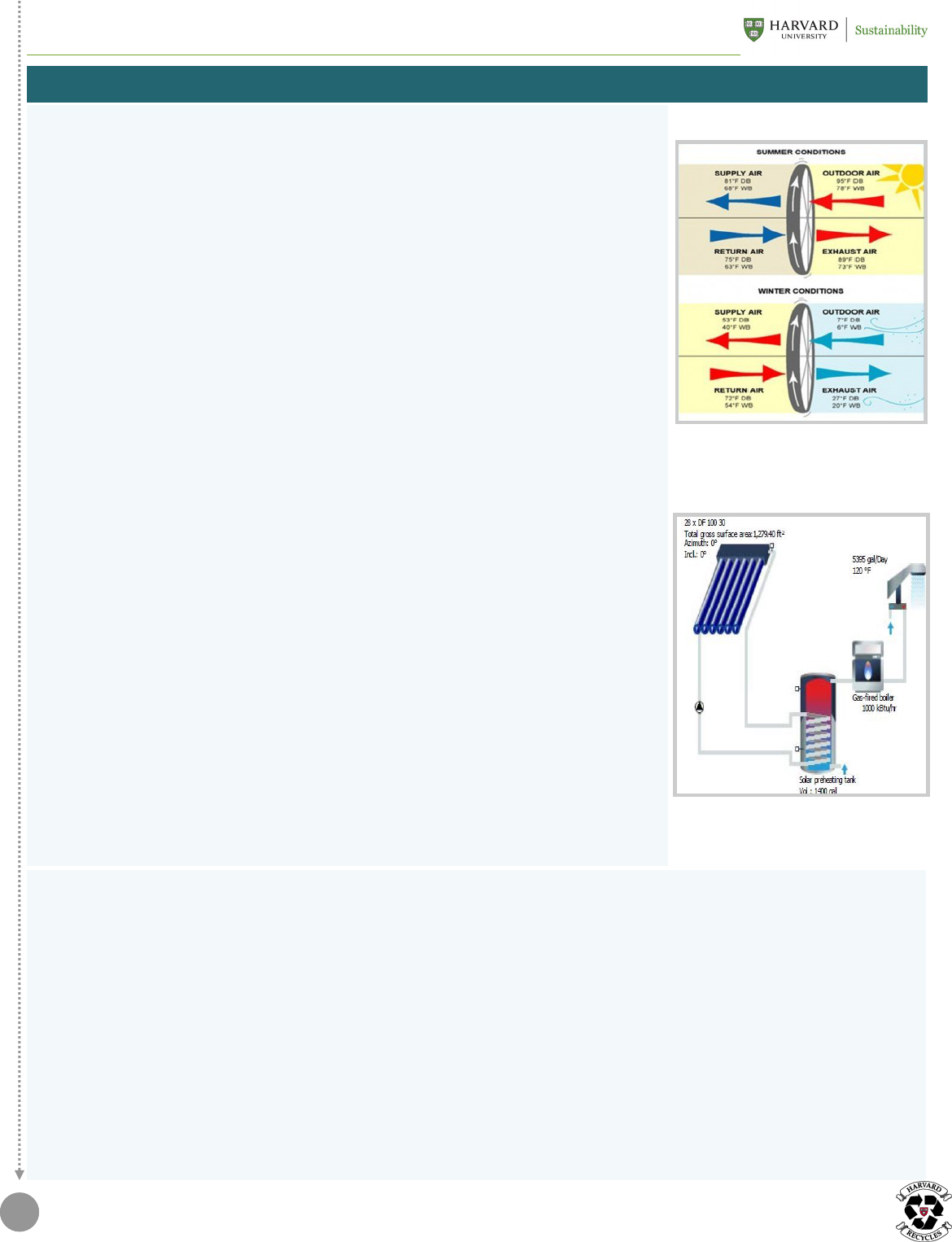
3
Please print this project profile only if necessary.
If printing is required, please print double sided and recycle when finished. Thank you!
The high indoor environmental quality of the Esteves Hall building was a signicant focus of the project. The selecon of low chemical-
eming building and nish materials, as well as appropriate construcon measures to prevent mold and mildew growth within the
building ensure a high level of indoor air quality, and thus occupant health, throughout the project. All chemical use spaces have auto
closing doors as well as compliant exhaust systems. To reduce contaminants brought in from the outdoors, all main entryways have
grills or oor mats. Other strategies to increase the indoor environmental quality addressed the lighng and thermal comfort of the
space. These included:
High eciency lighng with appropriate light levels
Filtered outdoor air for venlaon
Occupancy sensors and controls
Daylight access and views
Triple glazed windows installed on Northern side of building
ECM 1: High Efficiency Fan Coil Units (Living Groups and Bedrooms)
ECM 2: Enthalpy Recovery System
ECM 3: Window Sensors
ECM 4: Energy Efficient Lighting
ECM 5: Occupancy Sensors
ECM 6: Solar Thermal Hot Water System
The overall strategy of the HVAC system design was to reduce energy use through the
installaon of high eciency equipment and controls. The fans are controlled by variable
frequency drives and have variable air volume boxes downstream of the supply fans in order to
provide venlaon. Occupancy sensors ed to the fan coil units installed in the bedroom and
living areas control temperature setpoints and reduce HVAC system energy when these spaces
are unoccupied. Furthermore, window sensors shut down the fan coil units when the windows
are opened and CO
2
sensors were installed in densely occupied spaces in order to reduce
energy consumpon. The HVAC system also includes an enthalpy recovery system that
recovers energy from the exhaust air to precondion venlaon air (for dedicated outdoor air
units). All water-side systems in the building have variable ow pumping.
The solar thermal system uses 28 Kingspan DF100 30 ‘direct ow’ style evacuated tube
collectors which use energy provided by the sun to create domesc hot water. The system can
store up to 1,560 gallons of solar thermal hot water and is esmated to generate enough
energy to lower steam usage by 338 MMBtu annually, which is equivalent to reducing GHG
emissions by 24.8 MTCDE.
All lighng in the building is energy ecient uorescent or LED type. Lighng controls were
installed throughout the building including vacancy sensors for living areas and specic controls
for living group and common spaces. New electrical metering of distribuon panels serving
lighng, HVAC, and receptacle loads was also installed.
The building is provided with meters for all of the ulies serving the building (steam
condensate, heang load, chilled water, electricity), along with submetering of the lighng and
plug loads on a representave oor wing. This level of metering will be used by HBS to track
the energy usage of Esteves Hall and verify if the energy consumpon esmated during the
design stage of the project was accurate.
Typical Energy Exchange Through an Enthalpy
Wheel: Copyright DAC Sales (http://www.dac-
hvac.com/energy-recovery/energy-recovery-
wheels-what-is-an-enthalpy-wheel/), 2012
Solar Thermal System Graphic—Kingspan Solar,
2015

4
Please print this project profile only if necessary.
If printing is required, please print double sided and recycle when finished. Thank you!
Decreasing the demand for potable water is the rst step
towards sustainable water management. Sinks, toilets, uri-
nals, showers, and irrigaon systems that are designed to
use less water than typical xtures and systems are widely
available and when combined with conscienous occupant
use paerns and controls, can result in a large reducon in
water use.
Some of the water conservaon strategies incorporated in
the project include:
Low-ow plumbing xtures (urinals: 0.125 GPF; toilets:
1.28 GPF; showers: 1.5 GPM; lavatory faucets: 0.5 GPM)
Water ecient appliances
Water ecient irrigaon system
These strategies led to a 43% reducon in water use, com-
pared to the EPAct 1992 baseline.
The Esteves Hall landscape and site are designed to be
integrated into the Harvard Business School campus and
surrounding community. The design is centered on reduc-
ing and ltering stormwater runo, migang the urban
heat island eect, and creang a comfortable outdoor
environment around Esteves Hall.
The proximity to the Charles River makes stormwater
management a priority for the project. Using a Jellysh
Model, the site was designed to lter sediments and
phosphorous. Inltraon basins on the site then slowly
release stormwater during o peak hours. This system will
help reduce peak stormwater run-o rates to ease the
burden on the local infrastructure. In addion, storm-
water is also managed through the use of porous pave-
ment.
The project’s site design strategy to have limited hard-
scape and a vast vegetated area on the ground contrib-
utes to reducing the urban heat island eect. The design
also included a high albedo roof membrane, pavers with
high SRI values, and increased shading of the hardscape
areas.
For most of the landscaped areas, nave plant species
were used in order to help reduce the need for non-
natural ferlizers and pescides as well as decrease the
need for irrigaon.
1.28 GPF Toilet: Copyright American
Standard, 2012
0.125 GPF Urinal: Copyright American
Standard, 2012
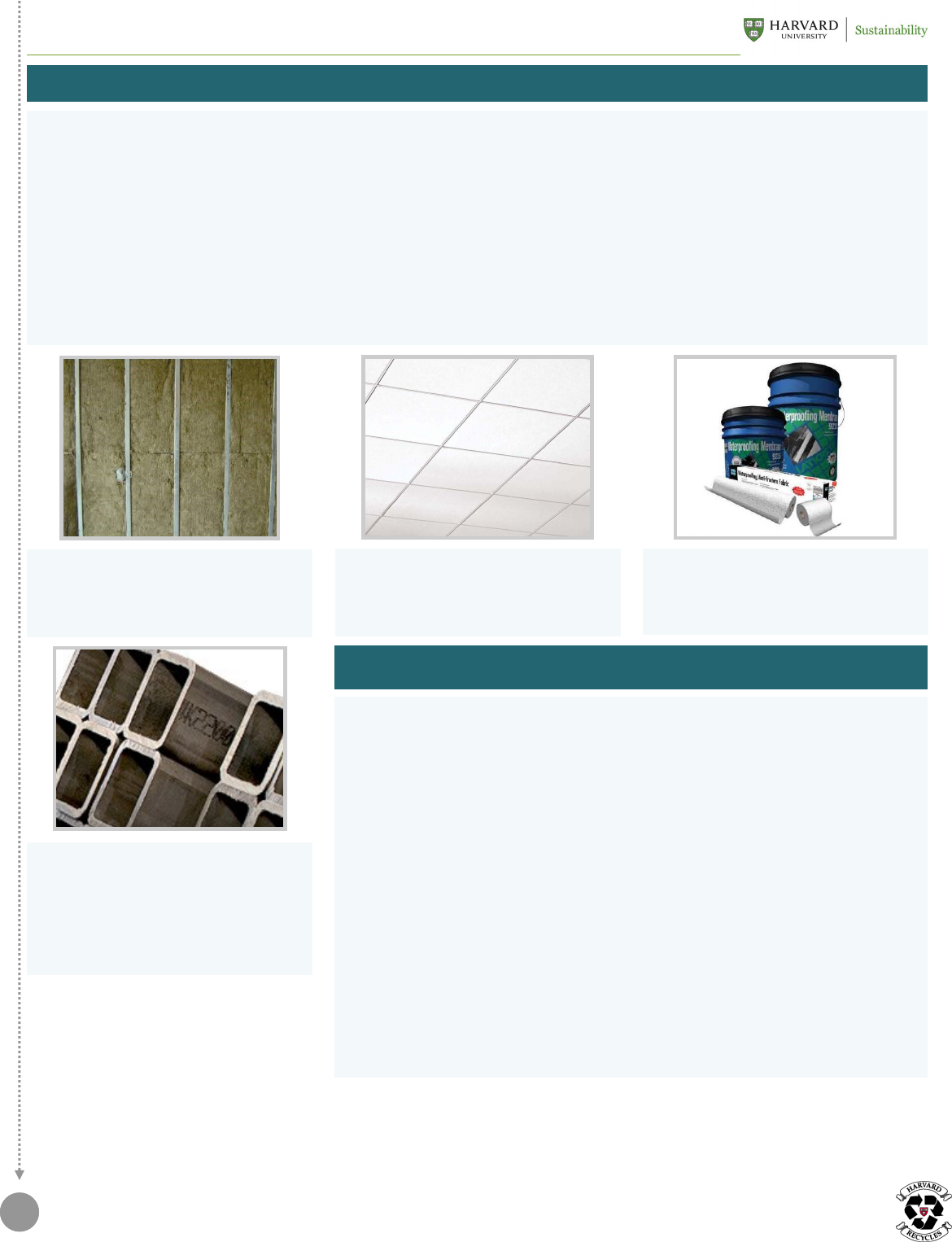
5
Please print this project profile only if necessary.
If printing is required, please print double sided and recycle when finished. Thank you!
Please note that while many products are described in this project profile, these are provided for informational purposes only,
to show a representative sample of what was included in this project. Harvard University and its affiliates do not specifically
endorse nor recommend any of the products listed in this project profile and this profile may not be used in commercial or
political materials, advertisements, emails, products, promotions that in any way suggests approval or endorsement of Harvard
University.
recycled materials (post-consumer content plus one-half
of pre-consumer content) value as a percentage of total
materials value
regional materials (manufactured within 500 miles) value
as a percentage of total materials value
interior ooring materials, nishes, and adhesives are low
eming
low-VOC, or no-VOC adhesives and sealants, were used
of construcon waste diverted from landll via recycling
and reuse
Materials for the Esteves Hall project were selected for their high recycled content, and whenever possible, local extracon and manu-
facture. Addionally, the majority of building woodwork is Forest Stewardship Council (FSC) cered wood, which comes from sustain-
ably managed forests. Recycled materials can either be post-consumer (material that has been through the public recycling process) or
pre-consumer (material that is a by-product of manufacturing). Local materials can be environmentally preferable because they re-
duce transportaon energy and support local economies. The material selecon process was also driven by the goal of creang a
healthy working environment that will improve occupant producvity and well-being. The design of the building interior can signi-
cantly contribute to this project goal.
The use of green building materials and along with high quality construcon methods can help achieve not only LEED points but also
support the local community. Making sustainable choices about the materials that went into Esteves Hall allowed the project to have a
posive impact on both building occupants and the building industry.
57% post-consumer recycled content
38% pre-consumer recycled content
Manufactured 488 miles from site
Materials extracted 282 miles from site
12% post-consumer recycled content
59% pre-consumer recycled content
Low-VOC: 2.4 g/L
GREENGUARD Cered
75% pre-consumer recycled content
Manufactured 454 miles from site
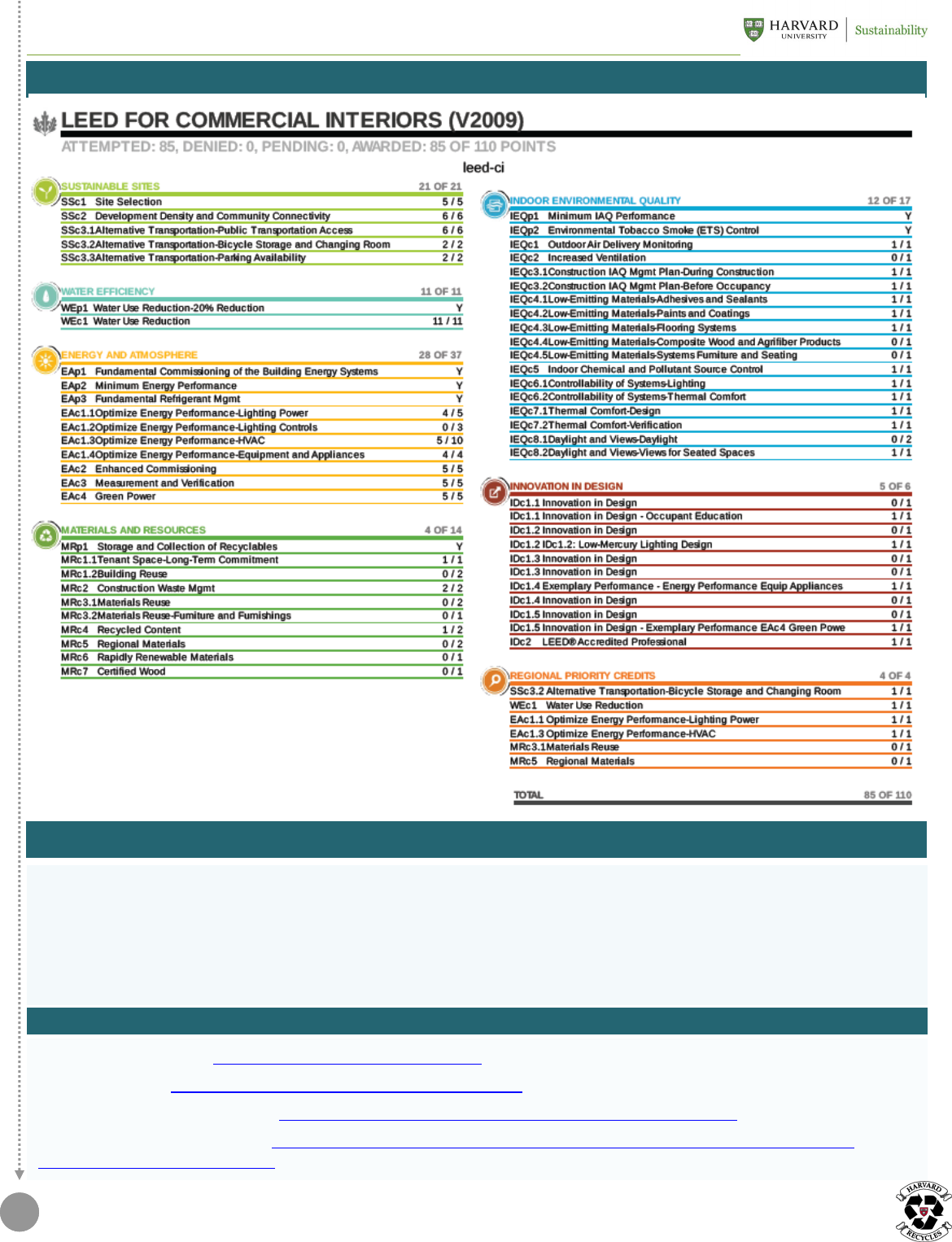
6
Please print this project profile only if necessary.
If printing is required, please print double sided and recycle when finished. Thank you!
Harvard Business School: hp://www.hbs.edu/Pages/default.aspx
HBS Sustainability: hp://green.harvard.edu/schools-units/business-hbs
Harvard—Green Building Resource: hp://www.energyandfacilies.harvard.edu/green-building-resource
Harvard—Green Building Services: hp://www.energyandfacilies.harvard.edu/project-technical-support/capital-projects/
sustainable-design-support-services
One of Esteves Hall’s key sustainability features is its solar thermal hot water system. The solar thermal system uses energy provided
by the sun and transfers this energy to create domesc hot water through the use of 28 Kingspan DF100 30 ‘direct ow’ style evacuat-
ed tube collectors. The hot water collecon tank is located in a central vault shared by both Esteves and the new Chao building, thus
allowing both buildings to ulize this hot water. In total, the system can store up to 1,560 gallons of solar thermal hot water. It is es-
mated the system will generate enough energy to lower steam usage by 338 MMBtu annually, which is equivalent to a reducing GHG
emissions by 24.8 MTCDE. This system is an excellent way to lower energy consumed for domesc hot water.
